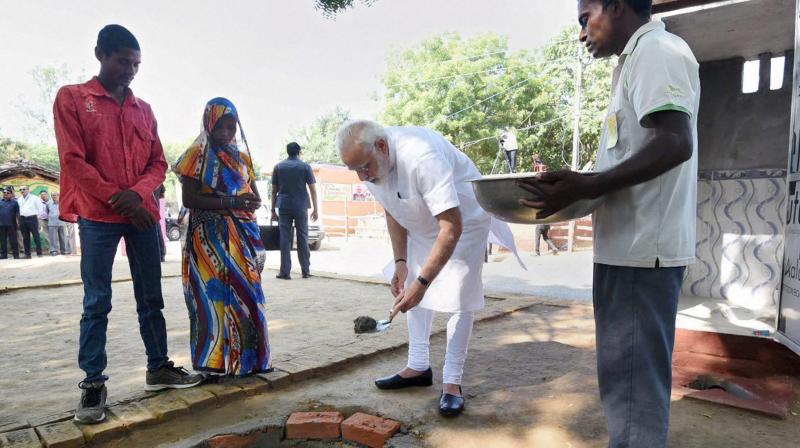More toilet talk vital for a cleaner India

Meeting sanitation targets is important but targets alone won’t mean much unless the people buy into the messages behind the toilet talk. Dhoom machaye broom. Toilet talk booms. But a clean India is much more than that.
Look back to the dramatic finding of Census 2011 about mobile phones and toilets. Fifty-three per cent of households had a mobile phone, while only 47 per cent had a toilet in their homes that year. Everyone gasped.
Today, while the number of households with toilets has risen sharply, mobile phone ownership continues to maintain its lead, or so non-governmental surveys tell us. The real issue, however, is not about toilet ownership but toilet usage, and the underlying reasons.
As we let the zillions of words uttered on the third anniversary of the Swachchh Bharat (Clean India) Mission soak in, here are some critical questions to chew on: why do so many people “feel the urgent need” for a mobile phone but not a toilet? More important, why do so many of those who have toilets not use them?
First things first. Even Narendra Modi’s bitterest critics admit the Prime Minister has invested enormous energy and resources in promoting Swachchh Bharat. It’s one of his government’s flagship programmes, and Mr Modi has passionately spoken about it from every available platform. That is a huge positive.
But here’s the rub. The zeal over toilet construction is all too evident. Less evident is the zeal to hammer home the message about why toilet use, washing hands with soap before meals and after easing oneself are “musts”, waste segregation and processing and the links between water, sanitation, hygiene and health.
The Accountability Initiative of the New Delhi-based Centre for Policy Research notes while building of individual household toilets accounts for the largest share of the Swachchh Bharat Mission’s total expenditure, and has been consistently rising over years, IEC (information, education and communication) gets a paltry eight per cent of the budget, and much of it is left unspent in many states. Most states were behind their targets for IEC expenditure in 2016-17. Till January 10, 2017, Chhattisgarh was the highest spender at 36 per cent, followed by Punjab at 35 per cent. Jammu and Kashmir hadn’t spent any funds, while Telangana and Rajasthan had spent a nominal one and three per cent respectively.
Prime ministerial endorsements do make a huge difference. The Press Information Bureau says over two lakh villages have become open defecation-free. All state governments are on board, but with varying degrees of success as with everything else in India. The high-decibel nationwide Clean India campaign has seen several politicians and celebrities, broom in hand, sweeping the streets. But of late, there are also numerous reports to suggest that the ground reality is somewhat different from the official narrative. In other words, meeting an official target in a hurry isn’t necessarily the best way to achieve sustainable behaviour change.
Mr Modi’s “New India” should take a leaf out of what old India did wrong. Nirmal Bharat Abhiyan, Swachchh Bharat’s predecessor, also focused more on toilet construction and less on making sure that people bought into toilet usage.
What was the result? Let’s rewind to the mobile phone/toilet analogy. The crucial difference between mobile usage and toilet usage in India is the “need” perception. India’s mobile or cellphone revolution happened as growing numbers of people in this emerging economy started seeing the cellphone as a “must-have” and a passport to upward mobility, and were willing to spend money to buy the gizmo, even if they had low incomes. The cellphone has emerged as a gadget of necessity in metros as much in small towns and villages.
Is there a similar buy-in for toilet use across India? If not, why?
Some years ago, I did a review of research studies commissioned by Unicef to understand this. The insights were useful. Traditionally, open defecation had social acceptance in India as in many other developing countries. Unsurprisingly, any campaign to promote toilet use, safe disposal of excreta, etc, faces huge resistance from many households and communities who consider toilets unclean. Many argue that since open fields in rural areas are available, where’s the need to build or use toilets? Rising literacy and exposure are denting these attitudes. But the fact remains there are still millions in this country who are illiterate and toilet construction alone isn’t enough to sell “sanitation” to them. Even many among those functionally literate need to be persuaded.
So what’s to be done? Acknowledge that access to a toilet does not always translate into usage or maintenance of toilets. Instead of focusing on just newly-built toilets, count broken toilets and those with erratic or non-existent water supply. Factor in the ground reality — because a house has a toilet does not mean everyone in that house uses it. Check who is really using the toilet and who is not, and why. Acknowledge that improved sanitation is still not a top priority for many households, as they don’t see toilets as a passport to upward mobility and better economic status. Feedback from the field in the earlier Nirmal Bharat Abhiyan showed that while communication campaigns helped drive home the nexus between using a toilet and washing hands with soap after defecation, before meals and before handling food, large numbers of people across India didn’t fully link specific diseases like diarrhoea with continuing open defecation.
There’s a lesson here — communication messages must be sharper; they also need to sledgehammer the point that even if a small segment of the population continues to practice open defecation, the risk of bacteriological contamination and disease may continue to be high.
The bottomline — meeting sanitation targets is important but targets alone won’t mean much unless the people themselves buy into the messages behind the toilet talk. Convince people — that’s where the money and energy need to be invested.

